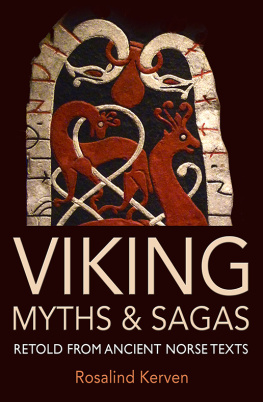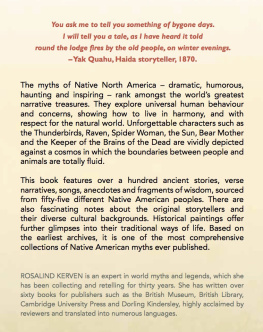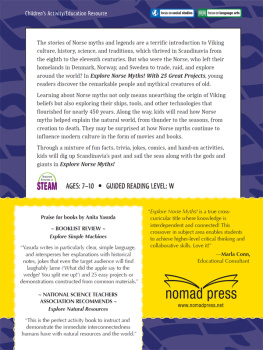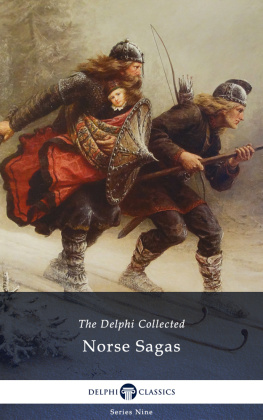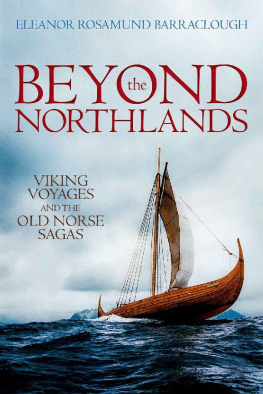I met a wild woman walking down the road. Her grey hair was grimy and unkempt, coiling round her shoulders like winter snakes, her eyes unnaturally bright.She hailed me and began to speak in a clear, compelling voice. This is what she told me...
The stories of the Viking Age rank amongst the worlds great narrative traditions. Preserved orally through countless generations and eventually transcribed in the 13th Century, their vividly imagined characters and high dramas are richly embroidered with dark humour and wisdom.
This definitive and unique collection presents thirty-four of the most important Viking myths, heroic legends and historical sagas, many previously known only within the academic world. Gods, giantesses, dwarfs, valkyries, ghosts and dragons mingle with real life queens, kings, slaves, lovers and outlaws. Visions of the mythical creation and end of the world contrast with a graphic account of the Vikings discovery of North America. It includes tales of the cursed ring that inspired Tolkien, and the story behind Shakespeares Hamlet.
Written by a master storyteller in consultation with leading scholars, the book also contains proverbs, spells, poems, riddles, detailed notes and a comprehensive glossary, offering a unique insight into Viking Age culture and beliefs.
ROSALIND KERVEN has been collecting and retelling world myths and legends for thirty years. She has written over sixty books for publishers such as the British Museum, British Library, Cambridge University Press and Dorling Kindersley, highly acclaimed by reviewers and translated into numerous languages.
Cover image:
Viking Age rune-stone
repainted in its original colours.
Historiska museet, Stockholm.
Photo Rosalind Kerven
We are very curious to see mighty folk
about whom great tales are told.
The Saga of Gisli the Outlaw
VIKING
MYTHS & SAGAS
Retold from ancient Norse texts
Rosalind Kerven

First published in the UK by Talking Stone 2015
Text copyright Rosalind Kerven 2015
Talking Stone
Swindonburn Cottage West, Sharperton
Morpeth, Northumberland, NE65 7AP
The moral right of Rosalind Kerven
to be identified as the author of this work
has been asserted in accordance with the
Copyright, Designs and Patents Act 1988
All rights reserved.
No part of this publication may be reproduced, stored in a retrieval system or transmitted in any form or by any means, electronic, mechanical, photocopying or otherwise, without the written permission of the publisher.
ISBN: 9781783016334
Names in SMALL CAPITALS refer to stories in this book.
Words and names in bold can be found in the Glossary.
The original versions of these stories were written in Old Norse, which contains a number of unfamiliar letters. For ease of reading, this book follows the conventions of modern scholars in anglicising the Old Norse names.
The book includes a number of quotes from Old Norse texts. Sometimes these are based on more than one translation, and are slightly adapted to improve clarity whilst still maintaining the original content and meaning.
For Richard
ACKNOWLEDGEMENTS
I would like to thank the following for their invaluable help and advice: Professor Diana Whaley, Newcastle University, who generously gave her time to advise on the Glossary, Introduction and skaldic verse. Professor Gisli Sigurdsson, University of Iceland, who comprehensively answered numerous questions, especially about the sagas. Dr Judy Quinn, Cambridge University, for clarifying various aspects of Eddic poetry and mythology. Dr Terry Gunnell, University of Iceland, for sending me his fascinating articles on Viking religion and the performance of Eddic poetry. Professor John McKinnell, Durham University, for his advice on dating the Eddic poems. I am also immensely grateful to all the scholars from the early 20th Century to the present day who have translated the Old Norse texts on which my retellings are based.
CONTENTS
from The Prose Edda
from The Prose Edda
+ The Poetic Edda (Voluspa, Vafthrudnismal)
from The Prose Edda
from The Poetic Edda (Thrymskvida)
from The Poetic Edda (Havamal)
from The Prose Edda + The Poetic Edda (Hymiskvida)
from The Prose Edda
from The Prose Edda
from The Prose Edda
from The Prose Edda
from The Prose Edda
from The Prose Edda
+ The Poetic Edda (Voluspa, Vafthrudnismal)
from The Prose Edda
from The Poetic Edda (various poems),
Prose Edda + Volsunga Saga
from The Poetic Edda (various poems),
Prose Edda + Volsunga Saga
from Hervarar Saga ok Heidreks
from The Poetic Edda (Rigsthula)
from The Poetic Edda (Grimnismal)
from Gesta Danorum
from Laxdaela Saga
from Landnamabok, Laxdaela Saga + Eiriks Saga
from Njals Saga
from Grettirs Saga
from Gisli Surssons Saga
from The Poetic Edda (Havamal), Grettirs Saga,
Laxdaela Saga, Volsunga Saga + Njals Saga
from The Prose Edda
from Laxdaela Saga
from The Poetic Edda (Volundarkvida)
from The Poetic Edda (Helgakvida Hundingsbana in fyrri, Helgakvida Hjorvardssonar, Helgakvida Hundingsbana onnur)
+ Volsunga Saga)
from Heimskringla
from Graenlendinga Saga + Eiriks Saga
from Yngvars Saga
From the Poetic Edda (Lokasenna, Oddrunargratr, Hyndluljod, Sigrdrifumal, Havamal), Heimskringla + Egils Saga
from Vatnsdaela Saga
from Graenlendinga Saga + Eiriks Saga
from Eyrbyggja Saga
from Njals Saga
from Laxdaela Saga
from Vatnsdaela Saga
The guest has arrived
Courteous words, then courteous silence
That he may tell his tale.
Havamal,Poetic Edda
VIKING PEOPLE
AND THEIR STORIES
The people we now call Vikings dominated northern Europe for three hundred years from the late 8th Century. Originally from Denmark, Norway and Sweden, their merchants, plunderers, armies and migrants carried Viking culture far and wide. They established flourishing colonies, particularly in the British Isles, Iceland and Greenland.
What was their world like, and what sort of lives did they lead?
Most of the Viking nations were warrior kingdoms, although Iceland and Greenland were democratic republics. Society was made up of nobles, freehold farmers, paid labourers and slaves. Political power and warfare were exclusively male preserves. However, women enjoyed a fair degree of influence and freedom; they could own land and property and had easy access to divorce.
The Viking landscape was overwhelmingly rural and most people worked on farms. Their rectangular houses were built of timber, turf or stone. The main room had broad benches along each long wall, for both sitting and sleeping, and was usually dominated by a large upright loom. Heating and cooking were from the central fire-pit, which burned wood or peat, whilst oil lamps provided lighting. Wealthy people had additional rooms and small bed-closets for the heads of the household; otherwise, everyone slept on the benches.
Next page
